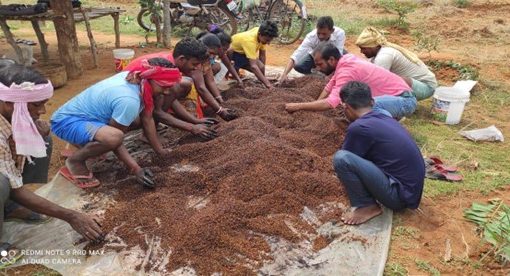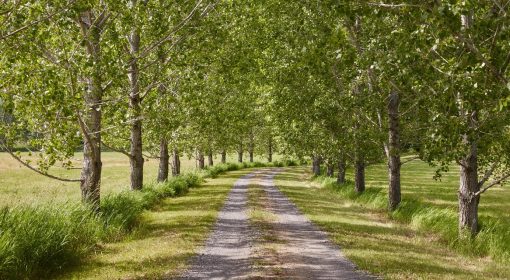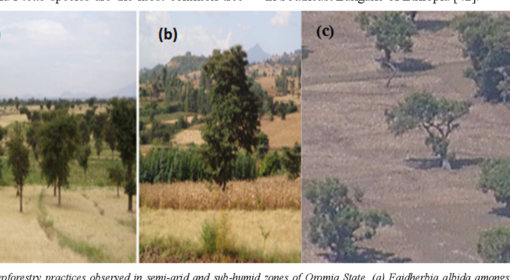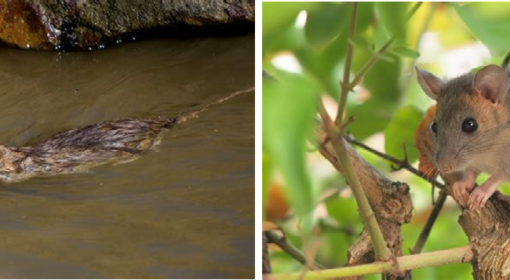By Marina Vara Gutierrez
Well-designed rainfed home gardens can increase crop productivity and increase biodiversity. Sustainably doing this requires a regenerative farming approach with reduced or eliminated use of external chemical inputs and tillage.
Specific targets of the design are:
- Increase the nutrient content of the soil (especially Nitrogen and Phosphor)
- Increase the production of fodder
- Increase plant, crop, and trees diversity
- Distribute tree and shrub species throughout the whole home garden area
- Define crop combinations and patterns which maximize production
- Reduce the risk of pests, weeds, and diseases

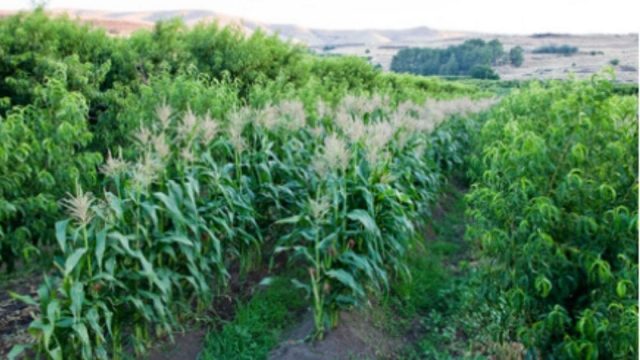
This blog discusses the case of small home gardens in the Amhara project area of Ethiopia. The image and scheme show a graphical representation of how the home garden’s design will look like. It is proposed to follow a strip cropping pattern to incorporate perennial woody species with crops, herbs, spices, and other plants. This pattern breaks with the traditional horizontal (North Ethiopia) and vertical (South Ethiopia) conventional home layout gardens. Still, it will increase productivity and agro-biodiversity in the tiny home gardens of the project area (0,25-1,25 ha).
The width of the crops/flower plants/grasses and tree/shrub strips will depend on the plot’s size. The narrower the stripes, the more intense the pruning of the woody perennials will need to be during the cropping season. When tree/shrub strips are incorporated (in alley cropping or hedgerow intercropping), the suggested space between rows ranges between 4-8 meters. The distance between seedlings within the tree/shrub strip is at least 2 meters. The strips should be in an east-west direction to ensure they receive sunlight throughout the day.
According to the proposed design, the aerial vision of the home garden could look like the following (the shadow tree area to produce the coffee intercropped with enset will only be considered for homesteads with enough space):
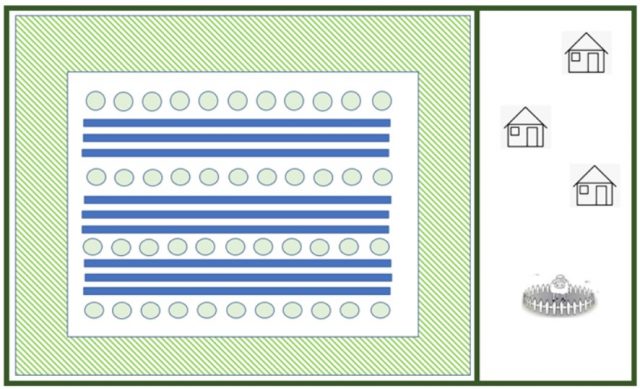
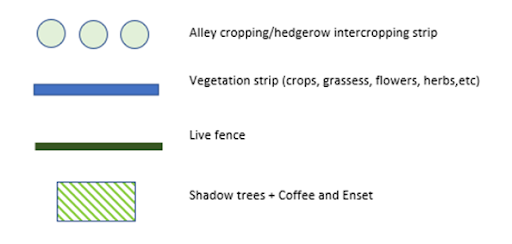
Intercropping crops in strips
Intercropping is a farming method which consists of planting or growing more than one crop at the same time and on the same piece of land. This is in the same row or bed or in rows or strips that are close enough for biological interaction. Mixed cropping, relay cropping, companion planting, and alley cropping, among others, are forms of intercropping with crops or perennial plants.
Intercropping is a practice especially advised for small plots. It is practiced with the aims to:
- Increase productivity per square meter.
- Increase time and energy efficiency.
- Mimic natural ecosystems where plants are always mixed.
- Increase production stability.
- Lower pests, disease and weed pressure.
- Attract pollinators.
The main intercropping principles which need to be considered to propose a successful crop combination for a strip are the following:
- Intercrop a tall, high-standing crop and a short, low-standing crop.
- Intercrop components crops (main crops) with different root architectures: shallow and deep rooting plants.
- To plant component crops with different lengths of growing period or when component crops have a similar length of the growing period, relay planting them.
- Adjust the spacing between component crops if their maturing period occurs at the exact moment.
- Mix as much as possible and plant companion crops with different pest and disease susceptibilities.
- To intercrop a component crop with good soil coverage.
- To take into account negative allelopathy and antagonisms.
- To avoid bare soils and ensure the management steps for one component crop do not inhibit the growth of another crop.
- To plant in rows.
- To intercrop only a few components crops.
Crop rotation
Crop rotation is another crucial practice in agroecological and regenerative farming. Crop rotation means changing the type of crops grown in the field each season or each year. In combination with intercropping, the application of animal and green manure and soil moisture practices will improve soil quality.
There are two main types of criteria for defining crop rotation patterns:
- Based on the family of the crop
- Based on the crop type (1st legumes, 2nd fruiting crops, 3rd leafy crops, 4th root crops)
Intercropping may also represent a problem for crop rotation. Knowing that one fundamental principle of crop rotation is the separation of plant families in time, replanting two families mixed in the same field may be difficult. However, good planning could maintain a viable crop rotation. For example, suppose a farm grows an area with tomato, squash, broccoli and lettuce. A simple rotation would put each crop in a different year, with a three-year interval before a crop is repeated on the same bed to control some diseases and pests. It is advisable to plant the previously proposed crop combination strips in different beds each year.
Alley cropping or hedgerow intercropping
Alley cropping, also known as hedgerow cropping, involves managing rows of woody plants with annual crops planted in alleys in between. The woody plants are cut regularly, and leaves and twigs are used as mulch on the cropped alleys to reduce evaporation from the soil surface, suppress weeds or add nutrients and organic matter to the topsoil. Where nitrogen is required for crop production, nitrogen-fixating plants might be the components of the hedgerows.
The primary purpose of alley cropping is to increase or maintain crop yields by improvement of the soil and microclimate and weed control. Farmers might also obtain tree products from the hedgerows, including fuel wood, building poles, medicine, and fodder, and on sloping lands, the hedgerow and pruning may help to control erosion.
Alley cropping usually works best when people need to intensify crop production but face soil fertility problems. This situation is often characteristic of crowded, densely populated areas but may also occur wherever some farmers wish or are forced to increase production on a plot of limited size. It is also a good practice to incorporate in areas where farmers do not implement fallow periods.
Ideally, hedgerows should be positioned in an east-west direction so that plants on both sides receive full sunlight during the day. On sloping land, hedgerows should always be placed on the contour. If it means that they do not have the desirable east-west orientation, then they may need regular trimming to prevent excessive shading of adjacent crops. The position and spacing of hedgerow and crop plants in alley cropping systems depend on plant species, climate, slope, soil conditions and the space required for the movement of people and tillage equipment.
It is advised to combine two or more species in the hedgerows. For example, fast-decomposing leaves trees release nitrogen quickly into the soil. A second species with longer-lasting leaves maintains soil cover throughout the cropping season and builds up organic matter in the topsoil. There is a solid need to combine water harvesting or moisture conservation techniques and adaptable species with alley-cropping practices to optimize the ecological and economic benefits of alley-cropping in dry areas.
For the Amhara region in Ethiopia, alley cropping is a practice suitable for crops such as maize, teff, wheat, barley, sorghum, millet, beans, etc.
Some criteria for selecting trees and shrubs for alley cropping are:
- Have the ability to fix nitrogen
- Have a deep-rooted main root
- Ability to withstand drought
- It should be small-sized for the ease of pruning and pollarding
- Have coppicing ability after pollarding and pruning
- Light crown for light penetration
- High decomposition rate
- Multipurpose
There should be enough space between the alley cropping rows and between the border of the crop strips and the alley strip. This is to avoid shadowing the crops after 4-5 years of establishment of the trees. Other management techniques to consider are: trees and shrubs used in alley cropping should be left to grow for 6-18 months before the first cutting. This first cutting should be late enough to allow the woody plants to have good root development and resilience, yet soon enough to avoid shading adjacent crops. Some fruit or timber trees, dispersed in the hedgerow, may grow to full size with little or no pruning. A standard alley cropping practice consists of coppicing hedgerow plants at the height of 30 to 60 cm, followed by lopping to the same size at intervals ranging from once a month (during the cropping season) to once a year (around the beginning of the cropping season). Farmers may vary the timing of hedgerow management tasks to fit in with ploughing or weeding schedules. The leaf mulch is usually applied just after land preparation or crop sowing.
Field spacing usually ranges from 4 to 8 meters between rows and 25 cm to 2 meters between trees within rows, depending on the crops and shrubs/trees planted. One or more strips with different crops, as proposed earlier in this blog, will be planted among the trees and shrubs.
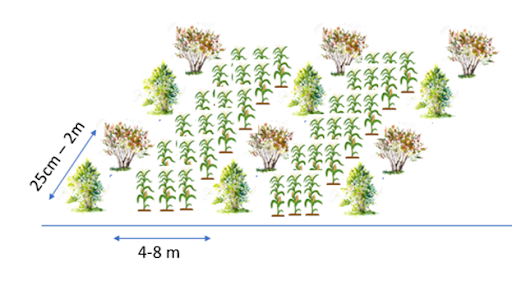
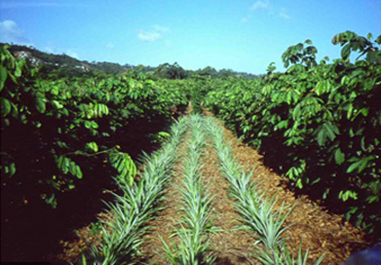
Live fencing
Trees or shrubs can be planted as live fences to avoid animal movement and provide plot demarcation. If multipurpose trees and shrubs are planted and properly managed, the live fence can also be a source of other products such as fodder, food, timber, woodfire, medicinal substances, etc. Live fences should be considered to be permanent or semi-permanent structures, and they require maintenance and are likely to affect more than one land user. They can easily be removed, but the labor and costs invested in establishing them will be lost. It is better to locate them carefully where they can benefit long-term. When a live fence is planned to demarcate a property line, all landowners and users affected should agree to its installation. They should also know their rights (harvesting) and responsibilities (maintenance).
Criteria for trees and shrubs selection are:
- Able to keep off livestock (thorny and/or densely branched)
- Easy to establish and maintain
- Resistant to fire
- Able to provide valuable by-products
The effective height of young trees can be boosted by planting them on earth banks or bunds to add some height in the initial growth stages. Where tree roots may compete with crops for nutrients and water, the borderline roots should be pruned by deep tilling or digging a trench about 50-100 cm away from the tree. In most living fences, most plants are low, rarely over 2 meters tall, and the fence as a whole is dense and impenetrable. Trees or shrubs are planted along the fence line at 30 to 90-cm intervals in one or more rows, straight or zig-zag.
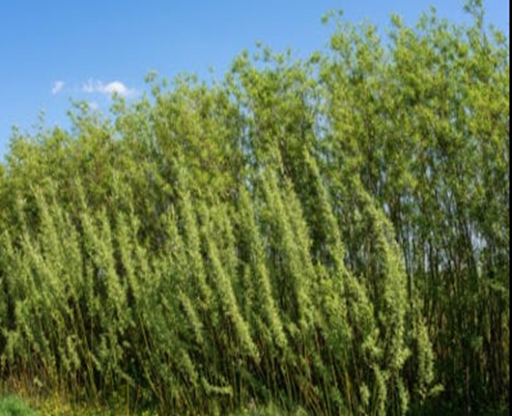
The home garden designs discussed in this blog can be applied in other areas as well, considering the local context and indigenous species of the area.
Supported by:

